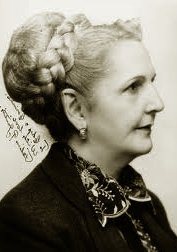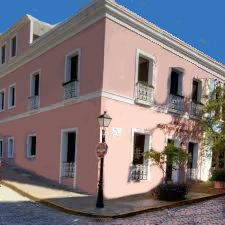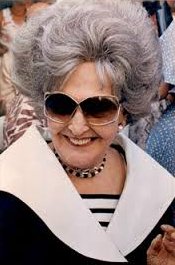

Official Biography
Edition and photos of the Museum by Luis
R. Negrón Hernández
Translation by Ann Shevlin
 Lea la versión en Español Lea la versión en Español
(c) CopyRight - Prohibido copiar, reproducir
 ELISA RINCÓN de Gautier, better know as Doña Felisa,
was the first woman to
hold the office of
mayor of an important city
in the Western
Hemisphere. She served
as mayor of San Juan
for a period of 22 years,
from 1946 to 1968.
She was a pioneer in the
movement for political
rights for women, in establishing
daycare
programs for preschool
children, and in establishing
the first legal aid and
medical assistance
centers for indigents.
A leader and role
model for Hispanics, she
also served as Goodwill
Ambassador under four North
American presidents.
She is one of the most
prominent Puerto Rican
figures in the political
history of our capital
city. ELISA RINCÓN de Gautier, better know as Doña Felisa,
was the first woman to
hold the office of
mayor of an important city
in the Western
Hemisphere. She served
as mayor of San Juan
for a period of 22 years,
from 1946 to 1968.
She was a pioneer in the
movement for political
rights for women, in establishing
daycare
programs for preschool
children, and in establishing
the first legal aid and
medical assistance
centers for indigents.
A leader and role
model for Hispanics, she
also served as Goodwill
Ambassador under four North
American presidents.
She is one of the most
prominent Puerto Rican
figures in the political
history of our capital
city.
Pioneer Puerto Rican suffragist and political
leader
Through the force of imagination,
ambition
and perseverance, Doña
Felisa became one
of the first women to vote
in Puerto Rico,
one of the first to hold
a leadership position
in a political party in
the 1930’s, and one
of the first to be named
to an important
public service position
in the decade of
1940. She broke down traditional sexist barriers
when she was named Mayor
of San Juan in 1946,
a position she occupied
with overwhelming
public support until January
of 1969. She
was a model public servant,
opening the door
for hundreds of other women
to participate
in the political process.
She worked tirelessly
to promote the electoral
participation of
Hispanics in the United
States, working actively
in presidential, congressional
and municipal
campaigns from 1936 on.
Photo: Puertorriqueñas sufragistas.
Roots, family
Doña Felisa was born in
the town of Ceiba,
Puerto Rico on January
9, 1897, the daughter
of Enrique Rincón, a lawyer,
and Rita Marrero,
a teacher. The oldest in
a family of nine
children, Doña Felisa,
at the young age of
12, had to take charge
of her brothers and
sisters when their mother
died.
 |
|

Museo Felisa Rincón de Gautier
(Viejo San Juan) |
|
 |
|
Doña Felisa studied in
the public schools
of Fajardo, Humacao and
Santurce, where she
finished high school. Responding
to her interest
in medicine and pharmaceutics,
she became
a practicing pharmacist.
Doña Felisa was
also a talented seamstress,
and her interest
in providing a source of
work to the unemployed
in Puerto Rico brought
her to travel to New
York to learn how to operate
a dress factory
and master the art of high
fashion design.
In time she opened a highly
successful clothing
shop, “Felisa’s Style Shop”,
and before that,
a florist shop. Her first
interest, nonetheless,
was always in helping and
serving people.
First steps in politics
Doña Felisa grew up in a home where her
father often hosted gatherings
in which he
would discuss political
and international
topics with some of the
great leaders of
the time. When women obtained
the right to
vote in Puerto Rico in
1932, Doña Felisa
was not only the fifth
women to register,
but also was named an official
representative
of the Liberal Party by
its president, Antonio
R. Barceló. Two weeks later
she was named
a member of the Executive
Committee of the
party. Photo at right: Antonio R. Barceló.
As a militant member of
the Liberal Party,
Felisa Rincón dedicated
herself to carrying
her party's message of
reform to the poor,
concentrating her efforts
in the worst slums
of Puerto Rico. After the
Liberal Party was
defeated in the elections
of 1936, she joined
Luis Muñoz Marín in 1938
to help form a new
political party, the Popular
Democratic Party
(PPD). Doña Felisa became
the President of
the San Juan Committee
of the PPD and in
1944 the party leadership
asked her to run
for Mayor, just as the
leaders of the Liberal
Party had asked her to
run for the Senate
in 1936. In 1946, challenging
the traditions
that were part of her upbringing,
she accepted
the appointment as Mayor
of San Juan, filling
out the term of Roberto
Sánchez Vilella.
Doña Felisa: 22 years as Mayor of San Juan
In Doña Felisa‘s 22 years
as Mayor, San Juan
grew in population from
180,000 to 450,000
inhabitants, becoming the finance and tourism
center of the Caribbean.
Under Doña Felisa’s
leadership, San Juan was
transformed into
one of the most beautiful
cities in the Hemisphere.
Working in close collaboration
with her good
friend and political leader
Luis Muñoz Marín,
she made significant contributions
to the
enormous task of rebuilding
the economic
infrastructure of Puerto
Rico, a task that
transformed the country
from one of the poorest
in the Western Hemisphere
into one of the
most highly developed.
Photo: Luis Muñoz Marín.
During her time in office,
the priority of
Doña Felisa was the welfare
of the people,
above all, that of the
poor and disabled.
Under her administration
many great projects
and pilot programs were
achieved. Doña Felisa
organized the first centers
of preschool
daycare in the Hemisphere,
the “Maternal
Schools”, which later served
as a model for
the “Head Start” program
in the U.S. in the
decade of the 1960’s. She
instituted clinics
and diagnostic centers
in the neighborhoods
of the Capital. She renovated
the San Juan
Municipal Hospital complex
and improved services
for ambulatory patients
there. The Municipal
Hospital of San Juan was
the first in the
island to receive full
accreditation from
the American Hospital Association
in 1948.
This made possible the
establishment of the
School of Medicine in 1950.
Doña Felisa also
established the first municipal
centers for
the care of the elderly
and the first centers
for legal aid to persons
of limited resources.
In 1959, the exemplary
leadership of Doña
Felisa in the area of conservation
methods
led to San Juan becoming
the recipient of
an “All American City Award”.
Beloved by the people
Under the administration of Doña Felisa,
the public always had access
to the mayor's
office. Her famous Wednesday
hearings allowed
citizens to feel confident
the Mayor would
try in every way to solve
the problems that
they brought to her attention.
At Christmas
time, the Mayor distributed
gifts to thousands
of needy families. She
also helped organize
youth baseball teams, providing
uniforms
and necessary equipment,
in addition to clearing
land to serve as ballparks
for neighborhood
children. Her efforts helped
in the formation
of Little League teams
throughout San Juan.
With limited resources,
but with total commitment
to providing the best to
her people, the
administration of Doña
Felisa achieved extraordinary
progress in the areas of
public welfare,
public works, and in expanding
educational
and cultural opportunities.
The success of the Mayor
was not limited
to Puerto Rico or to the
United States. Four
North American presidents
asked Doña Felisa
to serve as Goodwill Ambassador
to countries
in Latin American, Asia
and Europe. Her work
in Latin America is perhaps
one of her greatest
legacies, as few people
have done as much
as she did to promote understanding
and friendship
between the peoples of
Latin America and
the United States. She
was noted for being
an ardent defender of democracy
and social
justice in this hemisphere
for more than
half a century.
International praise
Doña Felisa received numerous
awards, decorations
and honorary degrees from
city and state governments, including recognition
from the governments of
France (Medal of
Joan of Arc), Spain (Gold
Medal of Honor,
Don Quixote Medal, and
The Medal of Isabella
the Catholic Queen); (The
Simon Bolivar Medal);
(The Award of the Order
of Merit) and from
Ecuador (Gold Medal of
Honor), among others.
In 1954, Doña Felisa was
recognized as “Woman
of the Americas” by the
Union of American
Women of New York for all
of her contributions
to the western hemisphere.
In 1958, Cardinal
Francis Spellman of the
Cathedral of St.
Patrick in New York conferred
upon her the
“Medal of the Holy Sepulcher
in Jerusalem”.
In 1961, Eleanor Roosevelt
presented her
the “Hebrew Philanthropic
Award”. All of
these honors transcend
political and geographical
barriers and recognize
Doña Felisa as a model
of the highest aspirations
that a person
can achieve. Photo: Doña “Fela” surrounded from left to
right by Hiram Cancio,
Ariel Colón, Arturo
Morales Carrión, Jaime
Benítez and Ricardo
E. Alegría.
At the age of 95
Even when she reached the age of 95, Doña
Felisa did not stop promoting
the worthy
causes that had been the
motivation of her
life's work. Her integrity,
devotion to duty,
dedication to the improvement
of opportunities
for the less fortunate
in society, and her
love and compassion toward
the people are
qualities that earned her
the title of one
of the most distinguished
public servants
of her time. It was clear
that she had great
love for her country and
for the promotion
democratic values abroad.
Photo: “L. Negrón
H.”: Parlor of the museum/residence
of Doña
Felisa in Old San Juan.
Photo: “L. Negrón H.”: Parlor of the museum
/ residence of Doña Felisa
in Old San Juan.
Final good-bye
Doña Felisa Rincón de Gautier
died the 16th
of September, 1994, in
the Home of Our Lady
of Providence in Puerta
de Tierra. She was
taken to the Ehret Funeral
Home where she was placed in the chapel until the 18th
of September where a mass
was celebrated
by Father Juan José Santiago.
Afterwards,
she was moved to the Sala
Capitular of the
San Juan City Hall, where
she remained until
the 19th of September,
during which time
she received demonstrations
of affection
from the people whom she
had loved and helped
so much. She was eulogized
for her accomplishments
on behalf of the progress
and welfare of
San Juan by former governors
Rafael Hernández
Colón (PPD), Luis A Ferré
(PNP), the mayor
of San Juan, Hector Luis
Acevedo, Miguel
A. Hernández Agist, Minority
speaker of the
Popular Party in the Senate,
and Rubio Bedoya,
of the Diplomatic Corps,
among many others.
Photo by Luis Negrón H.: Doña Felisa’s bedroom
in Old San Juan.
At 11:00 in the morning
she was taken to
the Cathedral of San Juan
where Cardinal
Luis Aponte Martínez celebrated
mass in her
memory. In both locations
the people carried
the coffin of Doña Felisa.
After mass the
funeral procession left
the Cathedral (Cristo
and Fortaleza Streets,
Ponce de León Avenue,
Fernández Juncos Avenue,
Muñoz Rivera Avenue)
and proceeded to the Monacillos
neighborhood
of Río Piedras where Doña
Felisa was buried
with the honors of a chief
of state.
|